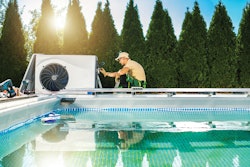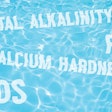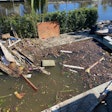
Within the pool and hot tub industry exists many trades, each having distinct opportunities, some apparent, others more discreet. For instance, our industry professionals in the construction and tile businesses are masters at creating the shell and surface of the pool. They also have opportunities to create beautiful tile patterns or even grand mosaics contributing to the pool’s aesthetic. Manufacturers of vinyl liners create the barrier that holds the water in, but the liners also impart the deep blue color to the water that we expect to see. However, all this hard work and beauty can be obscured, or worse, ruined if the water quality is poor and water turns cloudy.
Safety and drowning prevention are the main and most important reasons to maintain clear pool water. A cloudy pool can make it difficult for swimmers to see beneath the surface which can lead to collisions and possible life-threatening injuries. The drowning hazard from cloudy pool water is due to the inability to see a distressed swimmer beneath the surface of the water from above the surface.
Tragically, there are reported cases of drownings that occurred in supervised venues with lifeguards present. In these cases, the pool was cloudy, and the victims were not visible beneath the surface. These situations should NEVER occur, and pools should never be open for swimming when the bottom of the pool is not clearly visible.
Another reason that clear water is important in swimming pools is the overall appearance. Whether the pool is commercial or residential, pool users expect the water to have an inviting and pleasant appearance. Water that is hazy, dingy, or discolored is not appealing or inviting for swimmers.
Yet another reason water clarity is important has to do with disinfection. It is probable that cloudy water could be due to a lack of proper sanitizer. Swimmers who enter a cloudy pool with improper chlorine levels can be subject to bacterial infections such as swimmer’s ear or dermatitis. Also, there is the risk of enteric diseases such as Giardia, E. coli, and Cryptosporidium from swimming in a pool that is cloudy due to lack of sufficient sanitizer.
The turbidity is measured using a device known as a Nephelometer. This instrument measures light scattered by suspended particles in a water sample, at an angle of 90 degrees from the path of the incoming light beam. The amount of light scatter is related to the amount of turbidity and is expressed as NTUs. Health departments may allow pools at peak swimmer load to have 1.0 NTUs; however, the filter system must be able to return the water clarity to 0.5 NTU within eight hours after peak swimmer load.
There is a practical means by which a pool inspector will gauge water clarity. The inspector will want to clearly see a sharply defined drain at the deepest point in the pool from a spot on the pool deck; the acceptable distance away from the drain will be determined by local codes. If the bottom drain cannot be clearly seen, then the pool will be immediately closed until water clarity returns, and the drain can be seen with high definition.
Circulation and filtration are vital for the effective removal of micron-sized matter from the water. To grasp the scale, a micron is one millionth of a meter, and a grain of salt measures around 100 microns. The human eye can discern particles down to 35 microns. Filters are designed to remove particulate matter, with different types offering varying capabilities.
Rapid-rate sand filters, for instance, can eliminate particles down to 50 microns, while their high-rate counterparts excel further at eliminating particles down to 25 microns. Cartridge filters can typically remove even smaller particles, between 10 to 20 microns, while Diatomaceous Earth (D.E.) filters boast an impressive capacity to remove particles as small as 3 to 5 microns.
The efficiency of the chosen filter directly impacts water clarity, making it essential to match filtration capabilities with the desired level of clarity. If micron-sized material is allowed to accumulate, the small particles will combine by attractive forces, and the pool will become cloudy. All the water in a commercial swimming pool must turnover completely through the system once every six hours. It takes four complete turnovers of pool water to get 98% filtered water.
Chemical treatment for water clarity includes a regular routine of oxidation. Chlorine shocking or oxidizing with a potassium monopersulfate (nonchlorine) oxidizer is necessary to “burn off” organic material that can accumulate in the water. Additionally, the use of ozone and or UV will help to breakdown and remove particulate matter such as organics and minerals. This allows the chlorine to be more effective at sanitizing as well.
Special products, such as enzymes, water clarifiers or heavy flocs, can help the filters to be more efficient at the removal of smaller micron-sized matter. As always, follow the manufacturer’s instructions for optimal results. Another crucial water quality parameter that helps control water clarity is pH. The pH of the water will affect the solubility of certain compounds, like calcium carbonate; higher pH values increase the likelihood this mineral will precipitate from the water resulting in a cloudy pool.
Water clarity in swimming pools is crucial for several reasons. Firstly, clear water enhances the aesthetic appeal of the pool, providing a more enjoyable environment for swimmers. Additionally, it plays a vital role in ensuring the safety of individuals by allowing lifeguards and swimmers to easily detect potential hazards. Maintaining proper water balance is essential for clarity, as it prevents cloudy water, algae growth, and other factors that can compromise the overall quality of the pool water. For knowledge of industry-accepted standards, refer to ANSI/APSP/ICC-11 2019 American National Standard for Water Quality in Public Pools and Spas1.
REFERENCES
1. ANSI/APSP/ICC-11 2019 American National Standard for Water Quality in Public Pools and Spas, Pool & Hot Tub Alliance, 2019, www.phta.org
2. Pool & Spa Operator Handbook, Pool & Hot Tub Alliance, 2022, www.phta.org






































